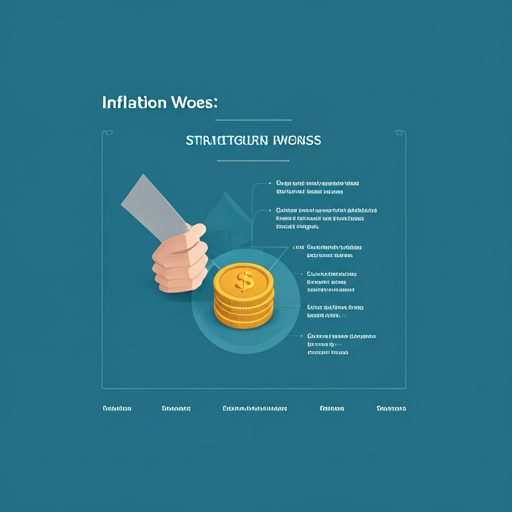Introduction to Inflation and Its Impact on Savings
Understanding Inflation: Causes and Effects
Inflation represents the rate at which the general level of prices for goods and services rises, eroding purchasing power. This phenomenon can significantly impact savings, as the real value of money diminishes over time. Individuals may find that their savings yield lower returns than inflation rates, leading to a loss of wealth. It’s crucial to understand this dynamic. Inflation can be insidious. He must consider alternative investment strategies to safeguard his assets.
The Historical Context of Inflation and Savings
Historically, inflation has fluctuated due to variouq economic factors, including supply shocks and monetary policy changes. These fluctuations have directly influenced savings behavior. For instance, during periods of high inflation, individuals often seek to invest rather than hold cash. This shift can lead to asset bubbles. He must remain vigilant about market trends. Understanding these historical patterns is essential. Knowledge is power in finance.
The Role of Cryptocurrency in an Inflationary Environment
How Cryptocurrencies Can Hedge Against Inflation
Cryptocurrencies offer a unique hedge against inflation due to their decentralized nature and limited supply. This scarcity can preserve value when fiat currencies depreciate. As inflation rises, he may consider reallocating assets into digital currencies. Diversification is key in investment strategies. Moreover, cryptocurrencies can provide liquidity in volatile markets. He should stay informed about market dynamics. Understanding these factors is crucial for effective financial planning.
Comparing Cryptocurrencies to Traditional Assets
When comparing cryptocurrencies to traditional assets, several key factors emerge. First, cryptocurrencies offer higher volatility, which can lead to significant gains or losses. In contrast, traditional assets like stocks and bonds tend to be more stable. Additionally, cryptocurrencies provide greater accessibility and liquidity. He should consider these differences carefully.
Understanding these distinctions is essential. Knowledge empowers better investment decisions.
Diversifying Your Investment Portfolio
The Importance of Asset Diversification
Asset diversification is crucial for mitigating risk in an investment portfolio. By spreading investments across various asset classes, he can reduce the impact of market volatility. This strategy enhances potential returns while minimizing losses.
He should evaluate his risk tolerance. A balanced approach is essential for long-term success.
Incorporating Cryptocurrencies into Your Portfolio
Incorporating cryptocurrencies into an investment portfolio can enhance diversification. By allocating a portion of assets to digital currencies, he can potentially increase returns. This approach balances traditional investments with high-growth opportunities.
He should assess market trends regularly. Staying informed is vital for success.
Stablecoins: A Safe Haven in Volatile Markets
What Are Stablecoins and How Do They Work?
Stablecoins are digital currencies designed to maintain a stable value, typically pegged to fiat currencies like the US dollar. This stability makes them attractive during market volatility. He can use stablecoins to preserve capital while still participating in the cryptocurrency market.
He should consider their benefits carefully. Stability is crucial in uncertain markets.
Using Stablecoins to Preserve Value
Using stablecoins allows investors to preserve value during market fluctuations. By pegging their worth to stable assets, these digital currencies mitigate the risks associated with volatility. He can easily convert cryptocurrencies into stablecoins to safeguard his investments.
He should evaluate their role in his portfolio. Stability is essential for financial security.
Investing in Precious Metals as a Complementary Strategy
The Historical Value of Gold and Silver
Here are 10 trending article titles for a financial website based on the latest news and analysis of financial trends: No input data
Integrating Precious Metals with Cryptocurrency Investments
Integrating precious metals with cryptocurrency investments can enhance portfolio stability. By combining these asset classes, he can mitigate risks associated with market volatility. Precious metals often retain value during economic downturns. This strategy provides a hedge against inflation.
He should consider this diversification approach. Balance is key in investing.
Building a Resilient Financial Strategy
Setting Financial Goals in an Inflationary Climate
Setting financial goals in an inflationary climate requires careful planning and adaptability. He should prioritize short-term and long-term objectives to navigate economic uncertainties.
He must regularly review these goals. Flexibility is essential in changing markets.
Regularly Reviewing and Adjusting Your Strategy
Regularly reviewing and adjusting one’s financial strategy is essential for long-term success. He should assess his investment performance and market conditions periodically. This proactive approach allows for timely adjustments to align with changing goals.
He must stay informed about market trends. Knowledge is crucial for effective decision-making.
Conclusion: Taking Action to Protect Your Savings
Summarizing Key Strategies for Inflation Protection
To protect savings from inflation, several key strategies can be employed. First, diversifying investments across asset classes can mitigate risks. He should consider incorporating cryptocurrencies and precious metals into his portfolio.
He must remain proactive in his approach. Action is essential for financial security.
Encouraging Proactive Financial Management
Proactive financial management is essential for long-term stableness. He should regularly assess his financial situation and adjust strategies accordingly. This includes setting clear financial goals and monitoring progress.
Knowledge leads to better financial decisions.
